Commercial Law
VerifiedAdded on 2023/06/07
|11
|3002
|120
AI Summary
This article discusses the legal system of Maori tribes, penalties imposed on criminal offenders in UK and Australia, fraudulent misrepresentation, and exclusion clause in contracts. It also includes case studies to explain the application of these concepts.
Contribute Materials
Your contribution can guide someone’s learning journey. Share your
documents today.
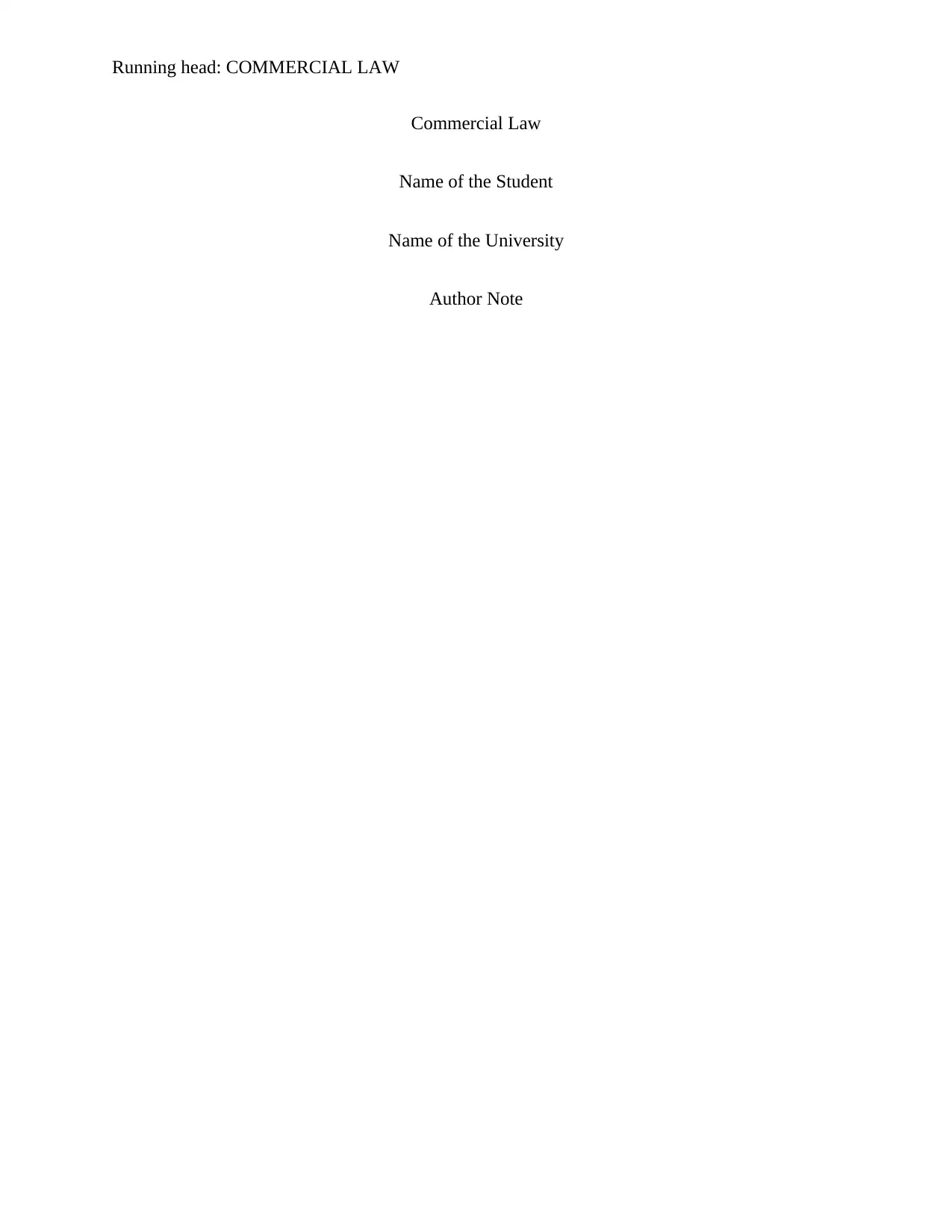
Running head: COMMERCIAL LAW
Commercial Law
Name of the Student
Name of the University
Author Note
Commercial Law
Name of the Student
Name of the University
Author Note
Secure Best Marks with AI Grader
Need help grading? Try our AI Grader for instant feedback on your assignments.
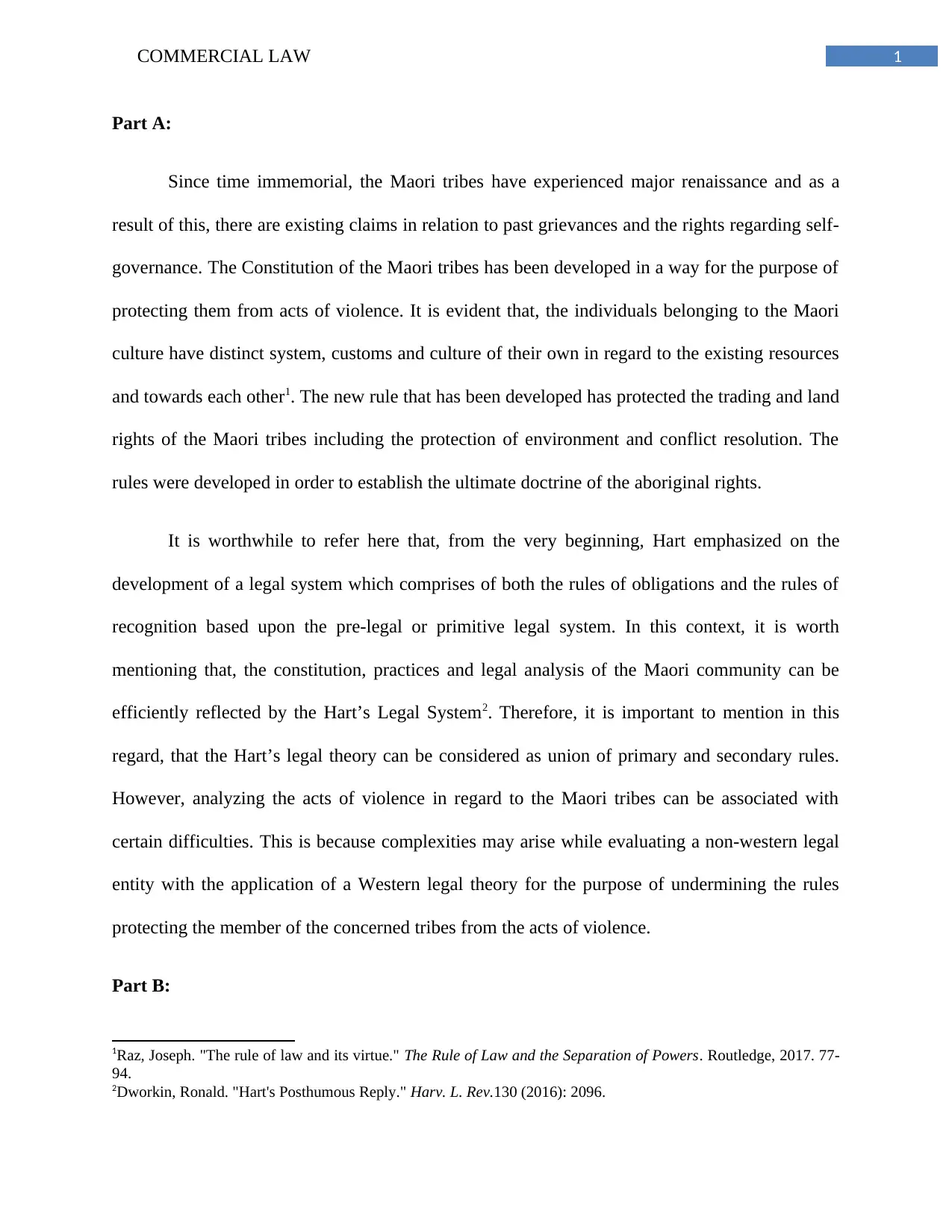
1COMMERCIAL LAW
Part A:
Since time immemorial, the Maori tribes have experienced major renaissance and as a
result of this, there are existing claims in relation to past grievances and the rights regarding self-
governance. The Constitution of the Maori tribes has been developed in a way for the purpose of
protecting them from acts of violence. It is evident that, the individuals belonging to the Maori
culture have distinct system, customs and culture of their own in regard to the existing resources
and towards each other1. The new rule that has been developed has protected the trading and land
rights of the Maori tribes including the protection of environment and conflict resolution. The
rules were developed in order to establish the ultimate doctrine of the aboriginal rights.
It is worthwhile to refer here that, from the very beginning, Hart emphasized on the
development of a legal system which comprises of both the rules of obligations and the rules of
recognition based upon the pre-legal or primitive legal system. In this context, it is worth
mentioning that, the constitution, practices and legal analysis of the Maori community can be
efficiently reflected by the Hart’s Legal System2. Therefore, it is important to mention in this
regard, that the Hart’s legal theory can be considered as union of primary and secondary rules.
However, analyzing the acts of violence in regard to the Maori tribes can be associated with
certain difficulties. This is because complexities may arise while evaluating a non-western legal
entity with the application of a Western legal theory for the purpose of undermining the rules
protecting the member of the concerned tribes from the acts of violence.
Part B:
1Raz, Joseph. "The rule of law and its virtue." The Rule of Law and the Separation of Powers. Routledge, 2017. 77-
94.
2Dworkin, Ronald. "Hart's Posthumous Reply." Harv. L. Rev.130 (2016): 2096.
Part A:
Since time immemorial, the Maori tribes have experienced major renaissance and as a
result of this, there are existing claims in relation to past grievances and the rights regarding self-
governance. The Constitution of the Maori tribes has been developed in a way for the purpose of
protecting them from acts of violence. It is evident that, the individuals belonging to the Maori
culture have distinct system, customs and culture of their own in regard to the existing resources
and towards each other1. The new rule that has been developed has protected the trading and land
rights of the Maori tribes including the protection of environment and conflict resolution. The
rules were developed in order to establish the ultimate doctrine of the aboriginal rights.
It is worthwhile to refer here that, from the very beginning, Hart emphasized on the
development of a legal system which comprises of both the rules of obligations and the rules of
recognition based upon the pre-legal or primitive legal system. In this context, it is worth
mentioning that, the constitution, practices and legal analysis of the Maori community can be
efficiently reflected by the Hart’s Legal System2. Therefore, it is important to mention in this
regard, that the Hart’s legal theory can be considered as union of primary and secondary rules.
However, analyzing the acts of violence in regard to the Maori tribes can be associated with
certain difficulties. This is because complexities may arise while evaluating a non-western legal
entity with the application of a Western legal theory for the purpose of undermining the rules
protecting the member of the concerned tribes from the acts of violence.
Part B:
1Raz, Joseph. "The rule of law and its virtue." The Rule of Law and the Separation of Powers. Routledge, 2017. 77-
94.
2Dworkin, Ronald. "Hart's Posthumous Reply." Harv. L. Rev.130 (2016): 2096.
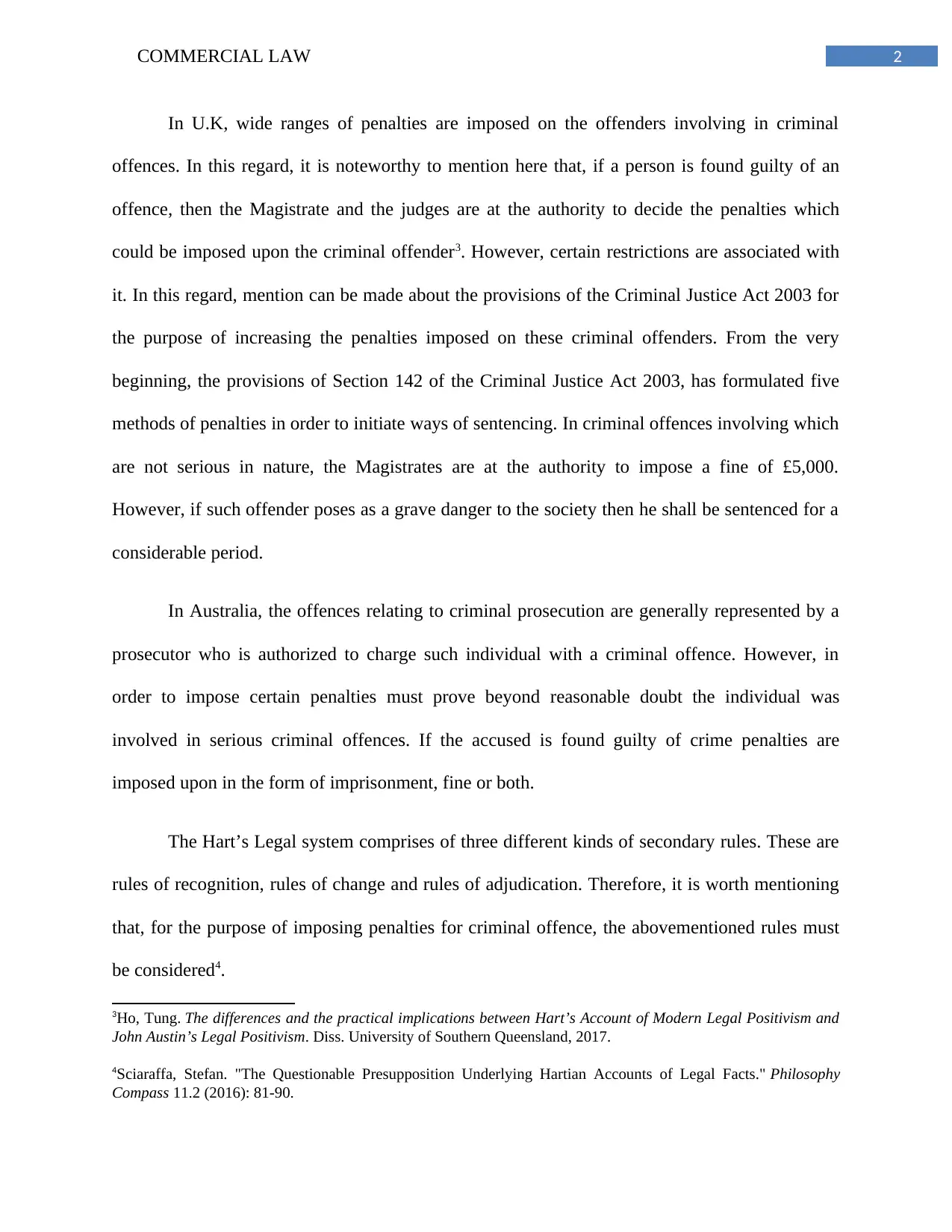
2COMMERCIAL LAW
In U.K, wide ranges of penalties are imposed on the offenders involving in criminal
offences. In this regard, it is noteworthy to mention here that, if a person is found guilty of an
offence, then the Magistrate and the judges are at the authority to decide the penalties which
could be imposed upon the criminal offender3. However, certain restrictions are associated with
it. In this regard, mention can be made about the provisions of the Criminal Justice Act 2003 for
the purpose of increasing the penalties imposed on these criminal offenders. From the very
beginning, the provisions of Section 142 of the Criminal Justice Act 2003, has formulated five
methods of penalties in order to initiate ways of sentencing. In criminal offences involving which
are not serious in nature, the Magistrates are at the authority to impose a fine of £5,000.
However, if such offender poses as a grave danger to the society then he shall be sentenced for a
considerable period.
In Australia, the offences relating to criminal prosecution are generally represented by a
prosecutor who is authorized to charge such individual with a criminal offence. However, in
order to impose certain penalties must prove beyond reasonable doubt the individual was
involved in serious criminal offences. If the accused is found guilty of crime penalties are
imposed upon in the form of imprisonment, fine or both.
The Hart’s Legal system comprises of three different kinds of secondary rules. These are
rules of recognition, rules of change and rules of adjudication. Therefore, it is worth mentioning
that, for the purpose of imposing penalties for criminal offence, the abovementioned rules must
be considered4.
3Ho, Tung. The differences and the practical implications between Hart’s Account of Modern Legal Positivism and
John Austin’s Legal Positivism. Diss. University of Southern Queensland, 2017.
4Sciaraffa, Stefan. "The Questionable Presupposition Underlying Hartian Accounts of Legal Facts." Philosophy
Compass 11.2 (2016): 81-90.
In U.K, wide ranges of penalties are imposed on the offenders involving in criminal
offences. In this regard, it is noteworthy to mention here that, if a person is found guilty of an
offence, then the Magistrate and the judges are at the authority to decide the penalties which
could be imposed upon the criminal offender3. However, certain restrictions are associated with
it. In this regard, mention can be made about the provisions of the Criminal Justice Act 2003 for
the purpose of increasing the penalties imposed on these criminal offenders. From the very
beginning, the provisions of Section 142 of the Criminal Justice Act 2003, has formulated five
methods of penalties in order to initiate ways of sentencing. In criminal offences involving which
are not serious in nature, the Magistrates are at the authority to impose a fine of £5,000.
However, if such offender poses as a grave danger to the society then he shall be sentenced for a
considerable period.
In Australia, the offences relating to criminal prosecution are generally represented by a
prosecutor who is authorized to charge such individual with a criminal offence. However, in
order to impose certain penalties must prove beyond reasonable doubt the individual was
involved in serious criminal offences. If the accused is found guilty of crime penalties are
imposed upon in the form of imprisonment, fine or both.
The Hart’s Legal system comprises of three different kinds of secondary rules. These are
rules of recognition, rules of change and rules of adjudication. Therefore, it is worth mentioning
that, for the purpose of imposing penalties for criminal offence, the abovementioned rules must
be considered4.
3Ho, Tung. The differences and the practical implications between Hart’s Account of Modern Legal Positivism and
John Austin’s Legal Positivism. Diss. University of Southern Queensland, 2017.
4Sciaraffa, Stefan. "The Questionable Presupposition Underlying Hartian Accounts of Legal Facts." Philosophy
Compass 11.2 (2016): 81-90.
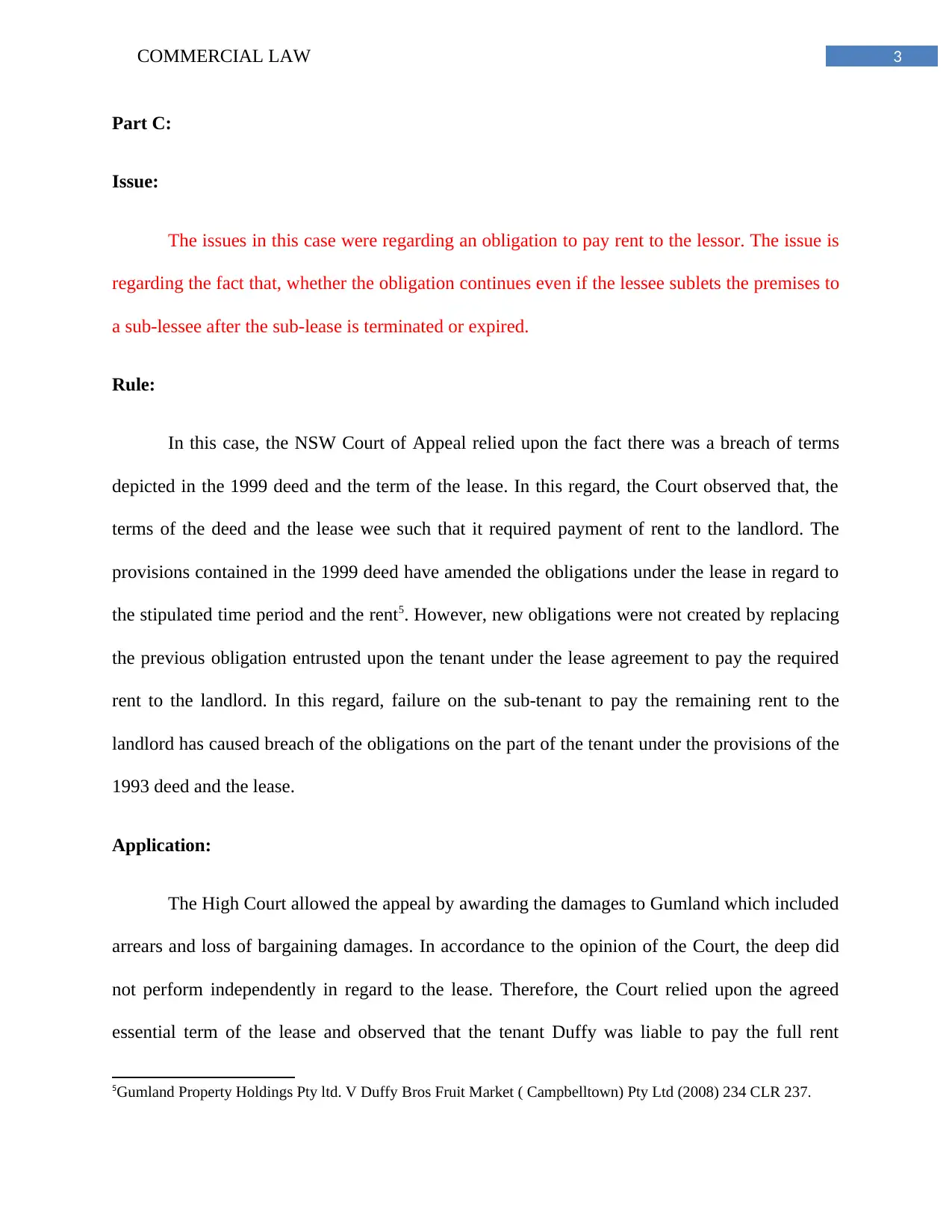
3COMMERCIAL LAW
Part C:
Issue:
The issues in this case were regarding an obligation to pay rent to the lessor. The issue is
regarding the fact that, whether the obligation continues even if the lessee sublets the premises to
a sub-lessee after the sub-lease is terminated or expired.
Rule:
In this case, the NSW Court of Appeal relied upon the fact there was a breach of terms
depicted in the 1999 deed and the term of the lease. In this regard, the Court observed that, the
terms of the deed and the lease wee such that it required payment of rent to the landlord. The
provisions contained in the 1999 deed have amended the obligations under the lease in regard to
the stipulated time period and the rent5. However, new obligations were not created by replacing
the previous obligation entrusted upon the tenant under the lease agreement to pay the required
rent to the landlord. In this regard, failure on the sub-tenant to pay the remaining rent to the
landlord has caused breach of the obligations on the part of the tenant under the provisions of the
1993 deed and the lease.
Application:
The High Court allowed the appeal by awarding the damages to Gumland which included
arrears and loss of bargaining damages. In accordance to the opinion of the Court, the deep did
not perform independently in regard to the lease. Therefore, the Court relied upon the agreed
essential term of the lease and observed that the tenant Duffy was liable to pay the full rent
5Gumland Property Holdings Pty ltd. V Duffy Bros Fruit Market ( Campbelltown) Pty Ltd (2008) 234 CLR 237.
Part C:
Issue:
The issues in this case were regarding an obligation to pay rent to the lessor. The issue is
regarding the fact that, whether the obligation continues even if the lessee sublets the premises to
a sub-lessee after the sub-lease is terminated or expired.
Rule:
In this case, the NSW Court of Appeal relied upon the fact there was a breach of terms
depicted in the 1999 deed and the term of the lease. In this regard, the Court observed that, the
terms of the deed and the lease wee such that it required payment of rent to the landlord. The
provisions contained in the 1999 deed have amended the obligations under the lease in regard to
the stipulated time period and the rent5. However, new obligations were not created by replacing
the previous obligation entrusted upon the tenant under the lease agreement to pay the required
rent to the landlord. In this regard, failure on the sub-tenant to pay the remaining rent to the
landlord has caused breach of the obligations on the part of the tenant under the provisions of the
1993 deed and the lease.
Application:
The High Court allowed the appeal by awarding the damages to Gumland which included
arrears and loss of bargaining damages. In accordance to the opinion of the Court, the deep did
not perform independently in regard to the lease. Therefore, the Court relied upon the agreed
essential term of the lease and observed that the tenant Duffy was liable to pay the full rent
5Gumland Property Holdings Pty ltd. V Duffy Bros Fruit Market ( Campbelltown) Pty Ltd (2008) 234 CLR 237.
Secure Best Marks with AI Grader
Need help grading? Try our AI Grader for instant feedback on your assignments.
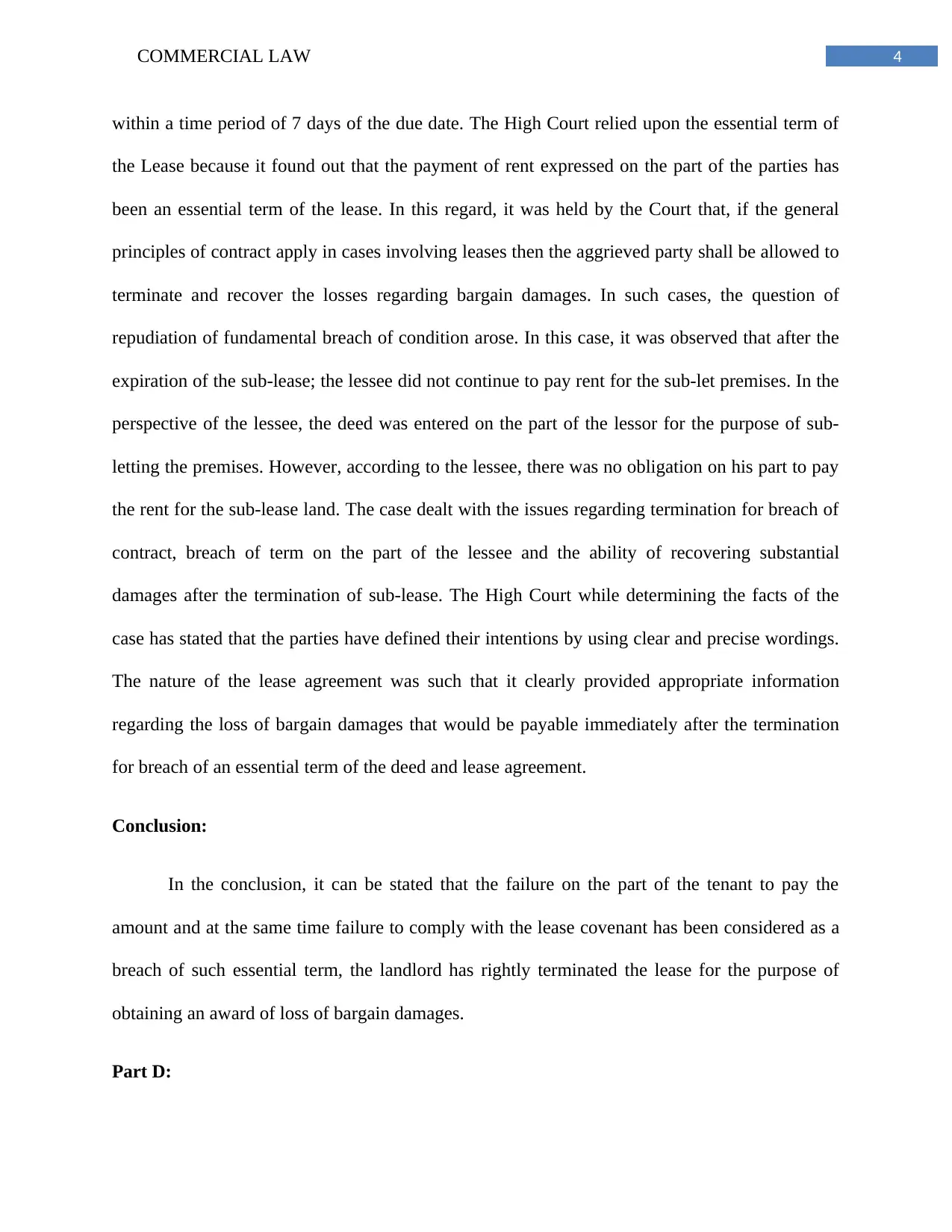
4COMMERCIAL LAW
within a time period of 7 days of the due date. The High Court relied upon the essential term of
the Lease because it found out that the payment of rent expressed on the part of the parties has
been an essential term of the lease. In this regard, it was held by the Court that, if the general
principles of contract apply in cases involving leases then the aggrieved party shall be allowed to
terminate and recover the losses regarding bargain damages. In such cases, the question of
repudiation of fundamental breach of condition arose. In this case, it was observed that after the
expiration of the sub-lease; the lessee did not continue to pay rent for the sub-let premises. In the
perspective of the lessee, the deed was entered on the part of the lessor for the purpose of sub-
letting the premises. However, according to the lessee, there was no obligation on his part to pay
the rent for the sub-lease land. The case dealt with the issues regarding termination for breach of
contract, breach of term on the part of the lessee and the ability of recovering substantial
damages after the termination of sub-lease. The High Court while determining the facts of the
case has stated that the parties have defined their intentions by using clear and precise wordings.
The nature of the lease agreement was such that it clearly provided appropriate information
regarding the loss of bargain damages that would be payable immediately after the termination
for breach of an essential term of the deed and lease agreement.
Conclusion:
In the conclusion, it can be stated that the failure on the part of the tenant to pay the
amount and at the same time failure to comply with the lease covenant has been considered as a
breach of such essential term, the landlord has rightly terminated the lease for the purpose of
obtaining an award of loss of bargain damages.
Part D:
within a time period of 7 days of the due date. The High Court relied upon the essential term of
the Lease because it found out that the payment of rent expressed on the part of the parties has
been an essential term of the lease. In this regard, it was held by the Court that, if the general
principles of contract apply in cases involving leases then the aggrieved party shall be allowed to
terminate and recover the losses regarding bargain damages. In such cases, the question of
repudiation of fundamental breach of condition arose. In this case, it was observed that after the
expiration of the sub-lease; the lessee did not continue to pay rent for the sub-let premises. In the
perspective of the lessee, the deed was entered on the part of the lessor for the purpose of sub-
letting the premises. However, according to the lessee, there was no obligation on his part to pay
the rent for the sub-lease land. The case dealt with the issues regarding termination for breach of
contract, breach of term on the part of the lessee and the ability of recovering substantial
damages after the termination of sub-lease. The High Court while determining the facts of the
case has stated that the parties have defined their intentions by using clear and precise wordings.
The nature of the lease agreement was such that it clearly provided appropriate information
regarding the loss of bargain damages that would be payable immediately after the termination
for breach of an essential term of the deed and lease agreement.
Conclusion:
In the conclusion, it can be stated that the failure on the part of the tenant to pay the
amount and at the same time failure to comply with the lease covenant has been considered as a
breach of such essential term, the landlord has rightly terminated the lease for the purpose of
obtaining an award of loss of bargain damages.
Part D:
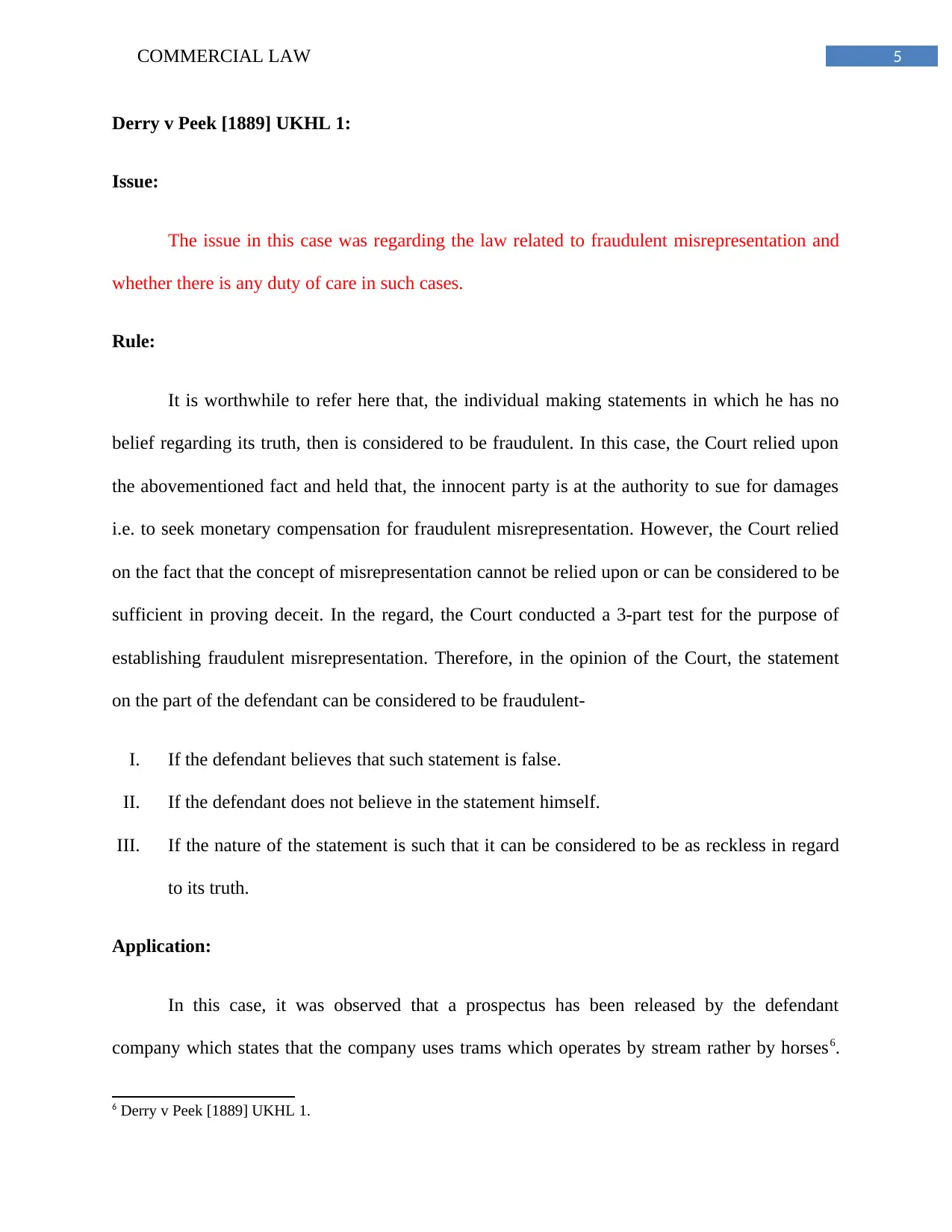
5COMMERCIAL LAW
Derry v Peek [1889] UKHL 1:
Issue:
The issue in this case was regarding the law related to fraudulent misrepresentation and
whether there is any duty of care in such cases.
Rule:
It is worthwhile to refer here that, the individual making statements in which he has no
belief regarding its truth, then is considered to be fraudulent. In this case, the Court relied upon
the abovementioned fact and held that, the innocent party is at the authority to sue for damages
i.e. to seek monetary compensation for fraudulent misrepresentation. However, the Court relied
on the fact that the concept of misrepresentation cannot be relied upon or can be considered to be
sufficient in proving deceit. In the regard, the Court conducted a 3-part test for the purpose of
establishing fraudulent misrepresentation. Therefore, in the opinion of the Court, the statement
on the part of the defendant can be considered to be fraudulent-
I. If the defendant believes that such statement is false.
II. If the defendant does not believe in the statement himself.
III. If the nature of the statement is such that it can be considered to be as reckless in regard
to its truth.
Application:
In this case, it was observed that a prospectus has been released by the defendant
company which states that the company uses trams which operates by stream rather by horses6.
6 Derry v Peek [1889] UKHL 1.
Derry v Peek [1889] UKHL 1:
Issue:
The issue in this case was regarding the law related to fraudulent misrepresentation and
whether there is any duty of care in such cases.
Rule:
It is worthwhile to refer here that, the individual making statements in which he has no
belief regarding its truth, then is considered to be fraudulent. In this case, the Court relied upon
the abovementioned fact and held that, the innocent party is at the authority to sue for damages
i.e. to seek monetary compensation for fraudulent misrepresentation. However, the Court relied
on the fact that the concept of misrepresentation cannot be relied upon or can be considered to be
sufficient in proving deceit. In the regard, the Court conducted a 3-part test for the purpose of
establishing fraudulent misrepresentation. Therefore, in the opinion of the Court, the statement
on the part of the defendant can be considered to be fraudulent-
I. If the defendant believes that such statement is false.
II. If the defendant does not believe in the statement himself.
III. If the nature of the statement is such that it can be considered to be as reckless in regard
to its truth.
Application:
In this case, it was observed that a prospectus has been released by the defendant
company which states that the company uses trams which operates by stream rather by horses6.
6 Derry v Peek [1889] UKHL 1.
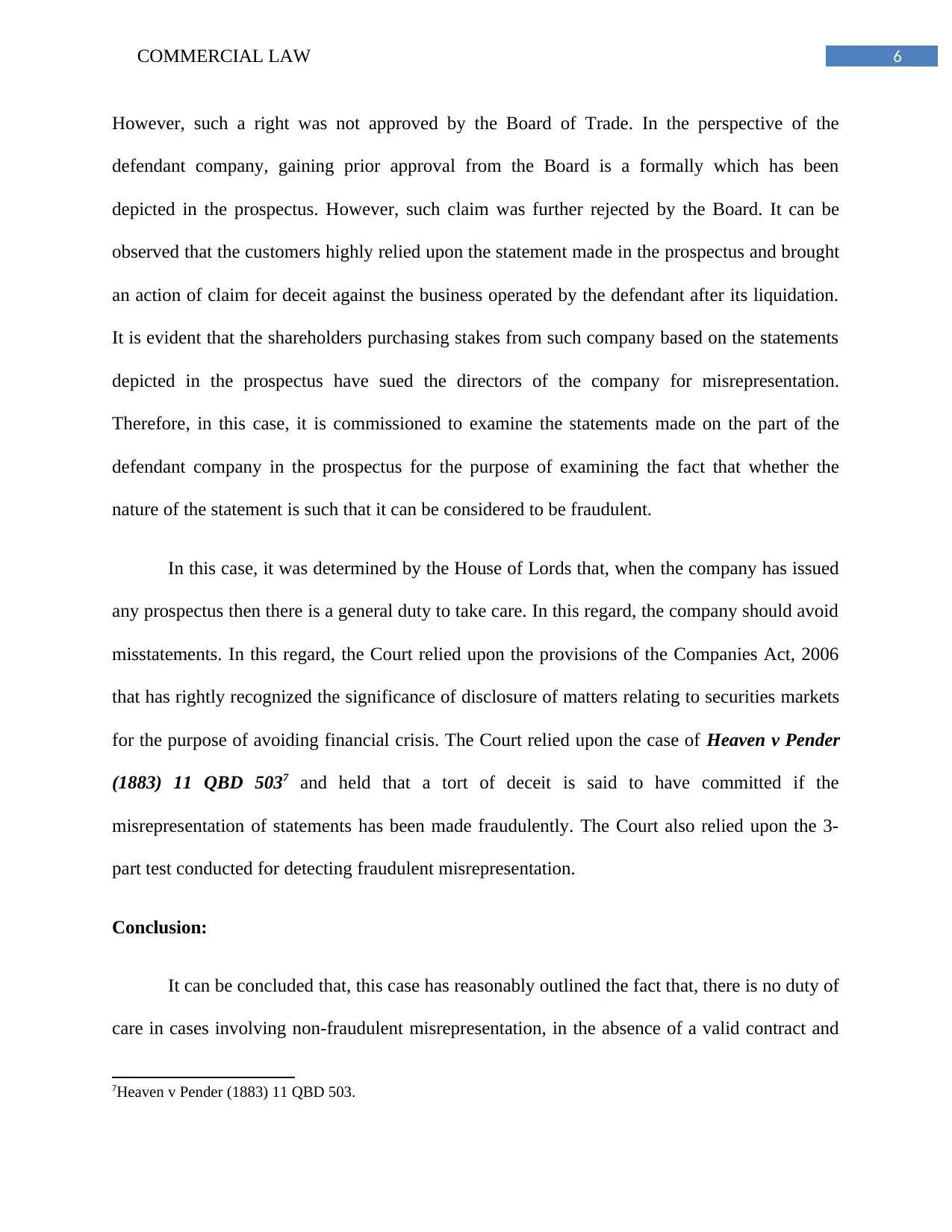
6COMMERCIAL LAW
However, such a right was not approved by the Board of Trade. In the perspective of the
defendant company, gaining prior approval from the Board is a formally which has been
depicted in the prospectus. However, such claim was further rejected by the Board. It can be
observed that the customers highly relied upon the statement made in the prospectus and brought
an action of claim for deceit against the business operated by the defendant after its liquidation.
It is evident that the shareholders purchasing stakes from such company based on the statements
depicted in the prospectus have sued the directors of the company for misrepresentation.
Therefore, in this case, it is commissioned to examine the statements made on the part of the
defendant company in the prospectus for the purpose of examining the fact that whether the
nature of the statement is such that it can be considered to be fraudulent.
In this case, it was determined by the House of Lords that, when the company has issued
any prospectus then there is a general duty to take care. In this regard, the company should avoid
misstatements. In this regard, the Court relied upon the provisions of the Companies Act, 2006
that has rightly recognized the significance of disclosure of matters relating to securities markets
for the purpose of avoiding financial crisis. The Court relied upon the case of Heaven v Pender
(1883) 11 QBD 5037 and held that a tort of deceit is said to have committed if the
misrepresentation of statements has been made fraudulently. The Court also relied upon the 3-
part test conducted for detecting fraudulent misrepresentation.
Conclusion:
It can be concluded that, this case has reasonably outlined the fact that, there is no duty of
care in cases involving non-fraudulent misrepresentation, in the absence of a valid contract and
7Heaven v Pender (1883) 11 QBD 503.
However, such a right was not approved by the Board of Trade. In the perspective of the
defendant company, gaining prior approval from the Board is a formally which has been
depicted in the prospectus. However, such claim was further rejected by the Board. It can be
observed that the customers highly relied upon the statement made in the prospectus and brought
an action of claim for deceit against the business operated by the defendant after its liquidation.
It is evident that the shareholders purchasing stakes from such company based on the statements
depicted in the prospectus have sued the directors of the company for misrepresentation.
Therefore, in this case, it is commissioned to examine the statements made on the part of the
defendant company in the prospectus for the purpose of examining the fact that whether the
nature of the statement is such that it can be considered to be fraudulent.
In this case, it was determined by the House of Lords that, when the company has issued
any prospectus then there is a general duty to take care. In this regard, the company should avoid
misstatements. In this regard, the Court relied upon the provisions of the Companies Act, 2006
that has rightly recognized the significance of disclosure of matters relating to securities markets
for the purpose of avoiding financial crisis. The Court relied upon the case of Heaven v Pender
(1883) 11 QBD 5037 and held that a tort of deceit is said to have committed if the
misrepresentation of statements has been made fraudulently. The Court also relied upon the 3-
part test conducted for detecting fraudulent misrepresentation.
Conclusion:
It can be concluded that, this case has reasonably outlined the fact that, there is no duty of
care in cases involving non-fraudulent misrepresentation, in the absence of a valid contract and
7Heaven v Pender (1883) 11 QBD 503.
Paraphrase This Document
Need a fresh take? Get an instant paraphrase of this document with our AI Paraphraser
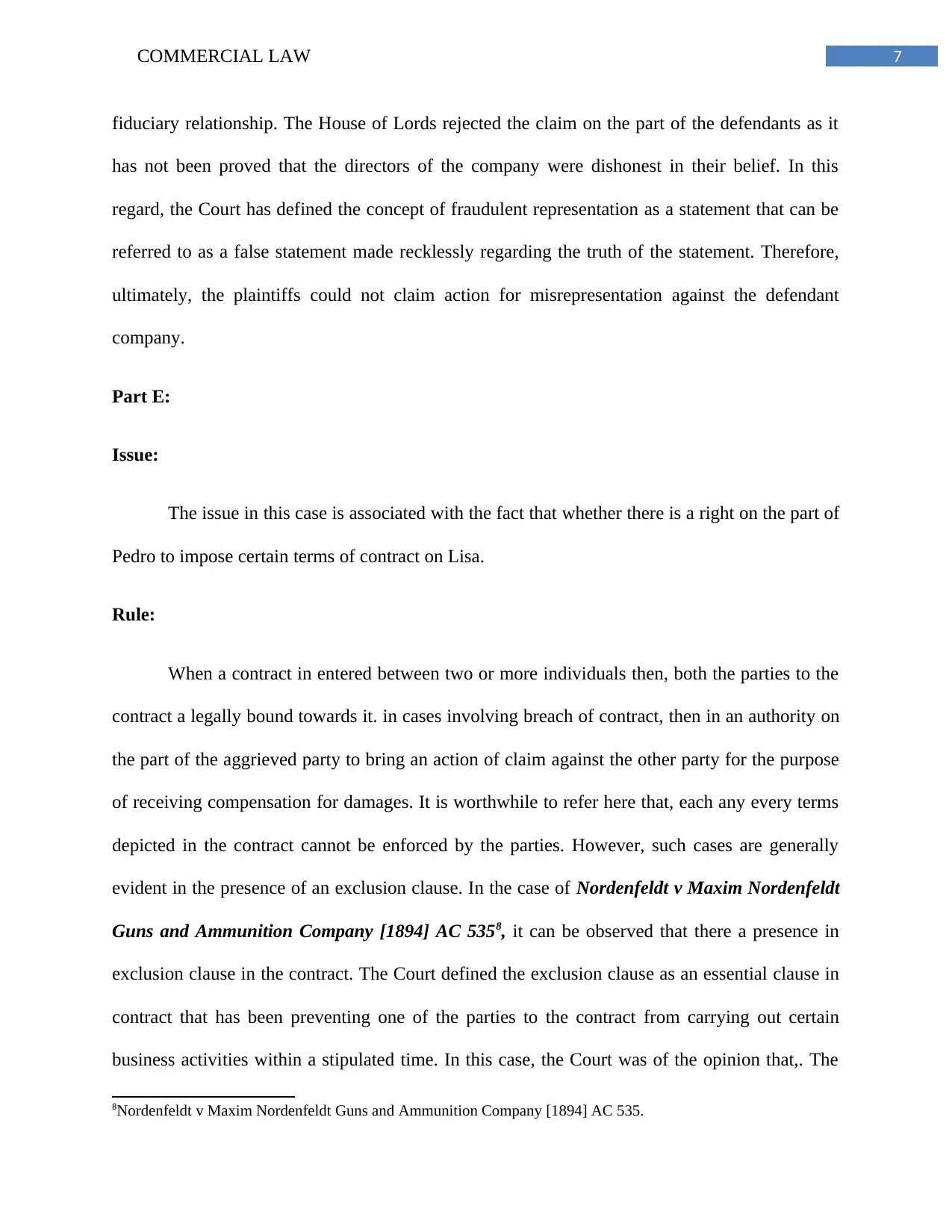
7COMMERCIAL LAW
fiduciary relationship. The House of Lords rejected the claim on the part of the defendants as it
has not been proved that the directors of the company were dishonest in their belief. In this
regard, the Court has defined the concept of fraudulent representation as a statement that can be
referred to as a false statement made recklessly regarding the truth of the statement. Therefore,
ultimately, the plaintiffs could not claim action for misrepresentation against the defendant
company.
Part E:
Issue:
The issue in this case is associated with the fact that whether there is a right on the part of
Pedro to impose certain terms of contract on Lisa.
Rule:
When a contract in entered between two or more individuals then, both the parties to the
contract a legally bound towards it. in cases involving breach of contract, then in an authority on
the part of the aggrieved party to bring an action of claim against the other party for the purpose
of receiving compensation for damages. It is worthwhile to refer here that, each any every terms
depicted in the contract cannot be enforced by the parties. However, such cases are generally
evident in the presence of an exclusion clause. In the case of Nordenfeldt v Maxim Nordenfeldt
Guns and Ammunition Company [1894] AC 5358, it can be observed that there a presence in
exclusion clause in the contract. The Court defined the exclusion clause as an essential clause in
contract that has been preventing one of the parties to the contract from carrying out certain
business activities within a stipulated time. In this case, the Court was of the opinion that,. The
8Nordenfeldt v Maxim Nordenfeldt Guns and Ammunition Company [1894] AC 535.
fiduciary relationship. The House of Lords rejected the claim on the part of the defendants as it
has not been proved that the directors of the company were dishonest in their belief. In this
regard, the Court has defined the concept of fraudulent representation as a statement that can be
referred to as a false statement made recklessly regarding the truth of the statement. Therefore,
ultimately, the plaintiffs could not claim action for misrepresentation against the defendant
company.
Part E:
Issue:
The issue in this case is associated with the fact that whether there is a right on the part of
Pedro to impose certain terms of contract on Lisa.
Rule:
When a contract in entered between two or more individuals then, both the parties to the
contract a legally bound towards it. in cases involving breach of contract, then in an authority on
the part of the aggrieved party to bring an action of claim against the other party for the purpose
of receiving compensation for damages. It is worthwhile to refer here that, each any every terms
depicted in the contract cannot be enforced by the parties. However, such cases are generally
evident in the presence of an exclusion clause. In the case of Nordenfeldt v Maxim Nordenfeldt
Guns and Ammunition Company [1894] AC 5358, it can be observed that there a presence in
exclusion clause in the contract. The Court defined the exclusion clause as an essential clause in
contract that has been preventing one of the parties to the contract from carrying out certain
business activities within a stipulated time. In this case, the Court was of the opinion that,. The
8Nordenfeldt v Maxim Nordenfeldt Guns and Ammunition Company [1894] AC 535.
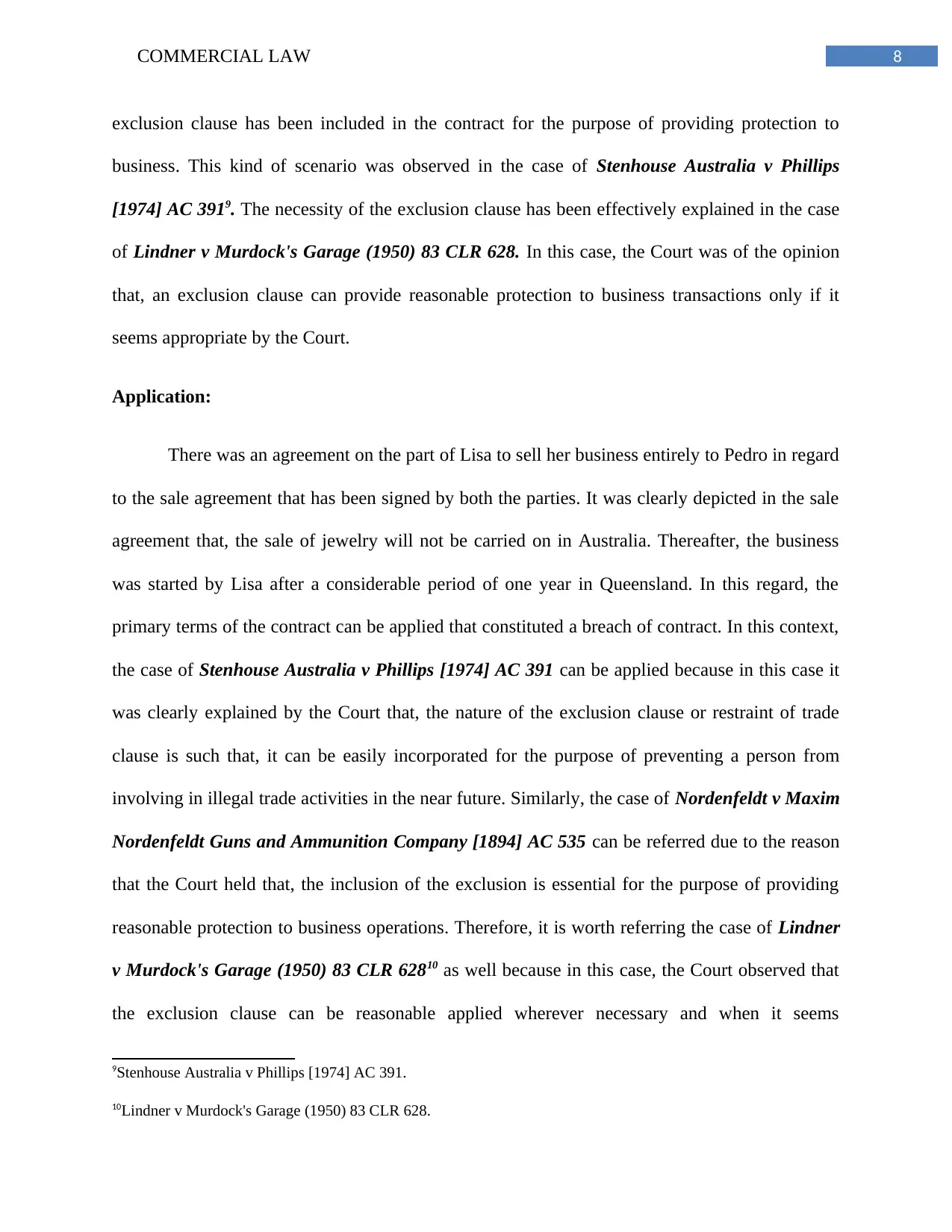
8COMMERCIAL LAW
exclusion clause has been included in the contract for the purpose of providing protection to
business. This kind of scenario was observed in the case of Stenhouse Australia v Phillips
[1974] AC 3919. The necessity of the exclusion clause has been effectively explained in the case
of Lindner v Murdock's Garage (1950) 83 CLR 628. In this case, the Court was of the opinion
that, an exclusion clause can provide reasonable protection to business transactions only if it
seems appropriate by the Court.
Application:
There was an agreement on the part of Lisa to sell her business entirely to Pedro in regard
to the sale agreement that has been signed by both the parties. It was clearly depicted in the sale
agreement that, the sale of jewelry will not be carried on in Australia. Thereafter, the business
was started by Lisa after a considerable period of one year in Queensland. In this regard, the
primary terms of the contract can be applied that constituted a breach of contract. In this context,
the case of Stenhouse Australia v Phillips [1974] AC 391 can be applied because in this case it
was clearly explained by the Court that, the nature of the exclusion clause or restraint of trade
clause is such that, it can be easily incorporated for the purpose of preventing a person from
involving in illegal trade activities in the near future. Similarly, the case of Nordenfeldt v Maxim
Nordenfeldt Guns and Ammunition Company [1894] AC 535 can be referred due to the reason
that the Court held that, the inclusion of the exclusion is essential for the purpose of providing
reasonable protection to business operations. Therefore, it is worth referring the case of Lindner
v Murdock's Garage (1950) 83 CLR 62810 as well because in this case, the Court observed that
the exclusion clause can be reasonable applied wherever necessary and when it seems
9Stenhouse Australia v Phillips [1974] AC 391.
10Lindner v Murdock's Garage (1950) 83 CLR 628.
exclusion clause has been included in the contract for the purpose of providing protection to
business. This kind of scenario was observed in the case of Stenhouse Australia v Phillips
[1974] AC 3919. The necessity of the exclusion clause has been effectively explained in the case
of Lindner v Murdock's Garage (1950) 83 CLR 628. In this case, the Court was of the opinion
that, an exclusion clause can provide reasonable protection to business transactions only if it
seems appropriate by the Court.
Application:
There was an agreement on the part of Lisa to sell her business entirely to Pedro in regard
to the sale agreement that has been signed by both the parties. It was clearly depicted in the sale
agreement that, the sale of jewelry will not be carried on in Australia. Thereafter, the business
was started by Lisa after a considerable period of one year in Queensland. In this regard, the
primary terms of the contract can be applied that constituted a breach of contract. In this context,
the case of Stenhouse Australia v Phillips [1974] AC 391 can be applied because in this case it
was clearly explained by the Court that, the nature of the exclusion clause or restraint of trade
clause is such that, it can be easily incorporated for the purpose of preventing a person from
involving in illegal trade activities in the near future. Similarly, the case of Nordenfeldt v Maxim
Nordenfeldt Guns and Ammunition Company [1894] AC 535 can be referred due to the reason
that the Court held that, the inclusion of the exclusion is essential for the purpose of providing
reasonable protection to business operations. Therefore, it is worth referring the case of Lindner
v Murdock's Garage (1950) 83 CLR 62810 as well because in this case, the Court observed that
the exclusion clause can be reasonable applied wherever necessary and when it seems
9Stenhouse Australia v Phillips [1974] AC 391.
10Lindner v Murdock's Garage (1950) 83 CLR 628.
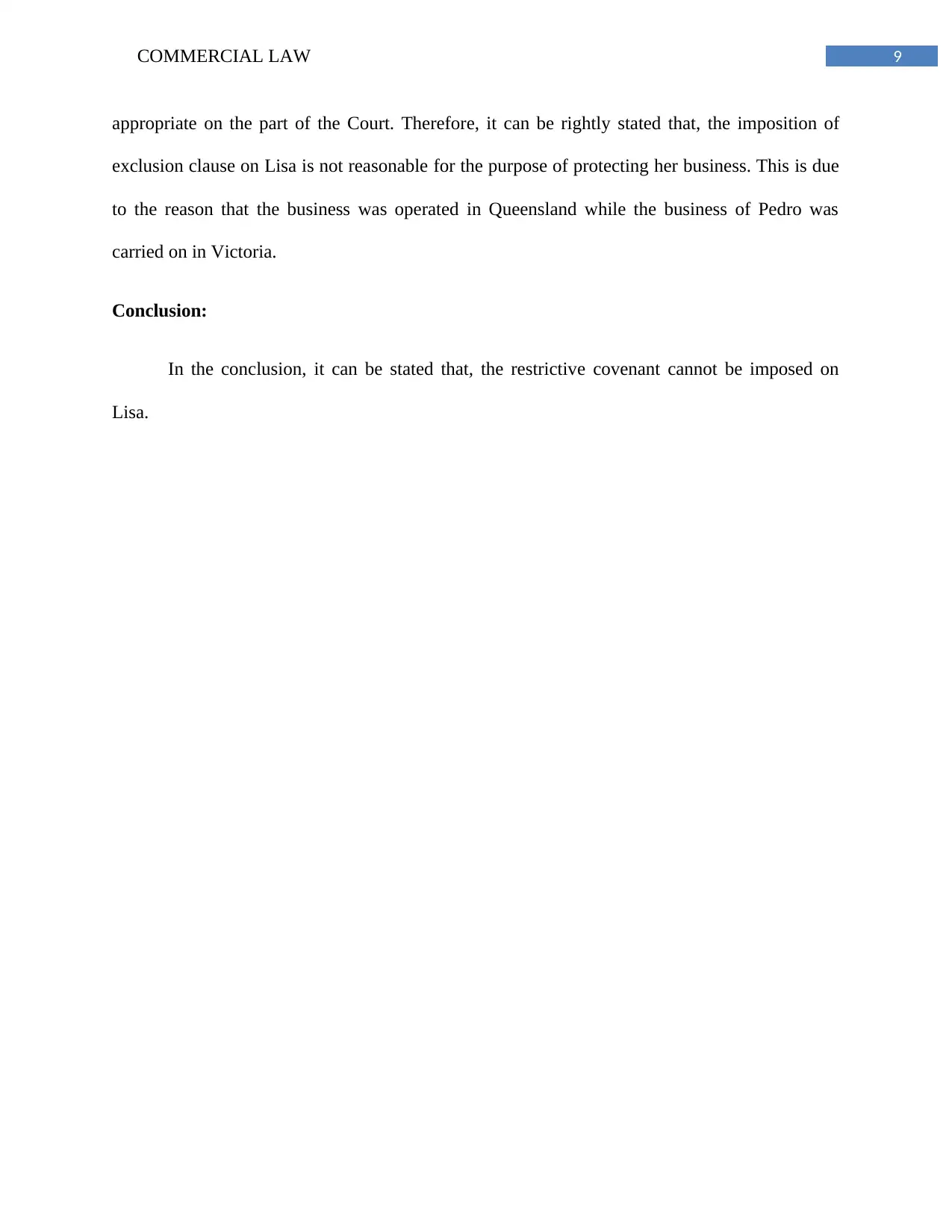
9COMMERCIAL LAW
appropriate on the part of the Court. Therefore, it can be rightly stated that, the imposition of
exclusion clause on Lisa is not reasonable for the purpose of protecting her business. This is due
to the reason that the business was operated in Queensland while the business of Pedro was
carried on in Victoria.
Conclusion:
In the conclusion, it can be stated that, the restrictive covenant cannot be imposed on
Lisa.
appropriate on the part of the Court. Therefore, it can be rightly stated that, the imposition of
exclusion clause on Lisa is not reasonable for the purpose of protecting her business. This is due
to the reason that the business was operated in Queensland while the business of Pedro was
carried on in Victoria.
Conclusion:
In the conclusion, it can be stated that, the restrictive covenant cannot be imposed on
Lisa.
Secure Best Marks with AI Grader
Need help grading? Try our AI Grader for instant feedback on your assignments.
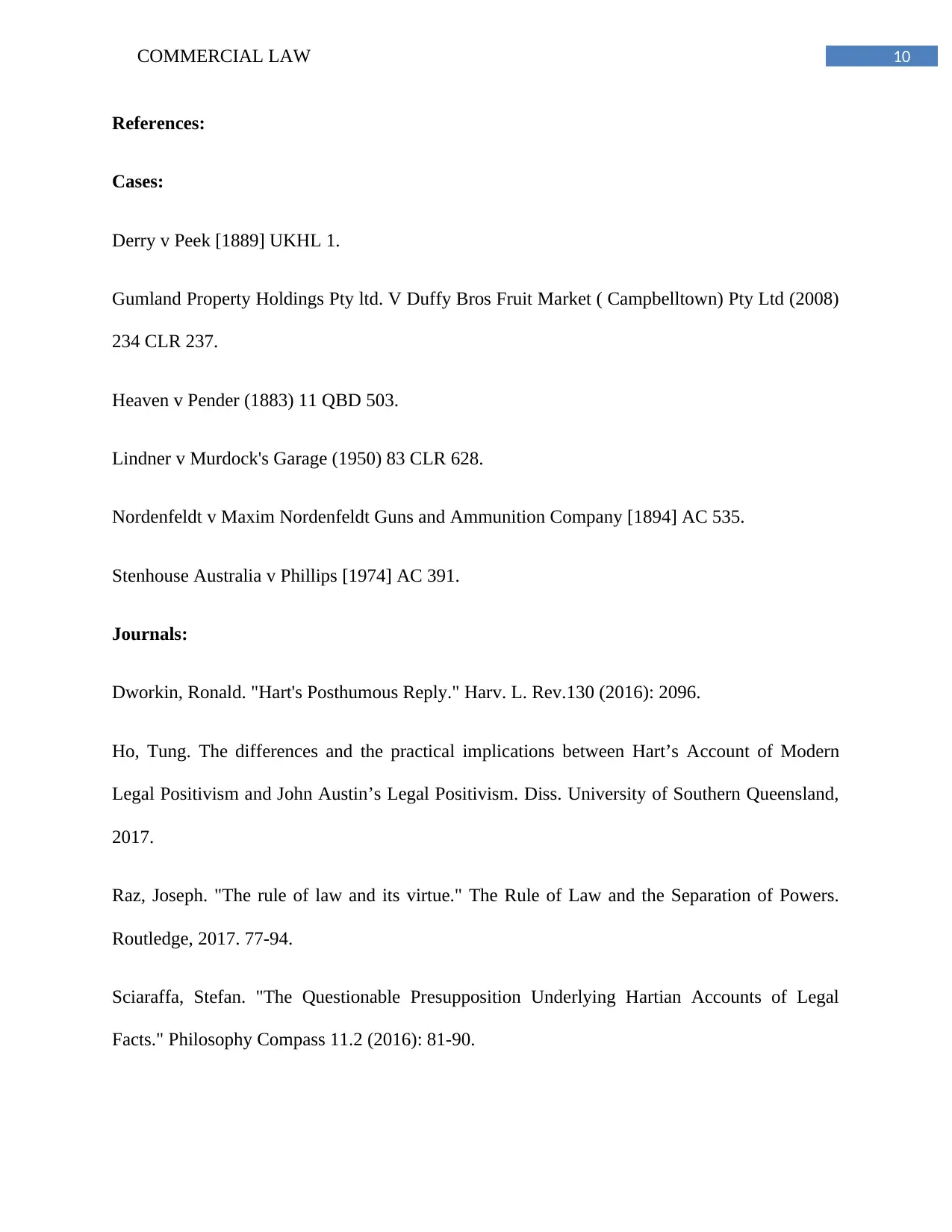
10COMMERCIAL LAW
References:
Cases:
Derry v Peek [1889] UKHL 1.
Gumland Property Holdings Pty ltd. V Duffy Bros Fruit Market ( Campbelltown) Pty Ltd (2008)
234 CLR 237.
Heaven v Pender (1883) 11 QBD 503.
Lindner v Murdock's Garage (1950) 83 CLR 628.
Nordenfeldt v Maxim Nordenfeldt Guns and Ammunition Company [1894] AC 535.
Stenhouse Australia v Phillips [1974] AC 391.
Journals:
Dworkin, Ronald. "Hart's Posthumous Reply." Harv. L. Rev.130 (2016): 2096.
Ho, Tung. The differences and the practical implications between Hart’s Account of Modern
Legal Positivism and John Austin’s Legal Positivism. Diss. University of Southern Queensland,
2017.
Raz, Joseph. "The rule of law and its virtue." The Rule of Law and the Separation of Powers.
Routledge, 2017. 77-94.
Sciaraffa, Stefan. "The Questionable Presupposition Underlying Hartian Accounts of Legal
Facts." Philosophy Compass 11.2 (2016): 81-90.
References:
Cases:
Derry v Peek [1889] UKHL 1.
Gumland Property Holdings Pty ltd. V Duffy Bros Fruit Market ( Campbelltown) Pty Ltd (2008)
234 CLR 237.
Heaven v Pender (1883) 11 QBD 503.
Lindner v Murdock's Garage (1950) 83 CLR 628.
Nordenfeldt v Maxim Nordenfeldt Guns and Ammunition Company [1894] AC 535.
Stenhouse Australia v Phillips [1974] AC 391.
Journals:
Dworkin, Ronald. "Hart's Posthumous Reply." Harv. L. Rev.130 (2016): 2096.
Ho, Tung. The differences and the practical implications between Hart’s Account of Modern
Legal Positivism and John Austin’s Legal Positivism. Diss. University of Southern Queensland,
2017.
Raz, Joseph. "The rule of law and its virtue." The Rule of Law and the Separation of Powers.
Routledge, 2017. 77-94.
Sciaraffa, Stefan. "The Questionable Presupposition Underlying Hartian Accounts of Legal
Facts." Philosophy Compass 11.2 (2016): 81-90.
1 out of 11
Related Documents
Your All-in-One AI-Powered Toolkit for Academic Success.
+13062052269
info@desklib.com
Available 24*7 on WhatsApp / Email
![[object Object]](/_next/static/media/star-bottom.7253800d.svg)
Unlock your academic potential
© 2024 | Zucol Services PVT LTD | All rights reserved.




